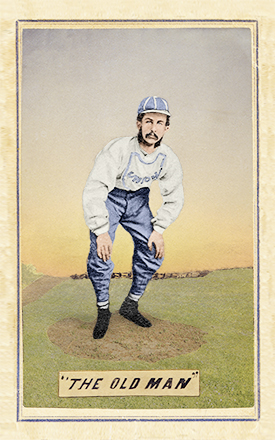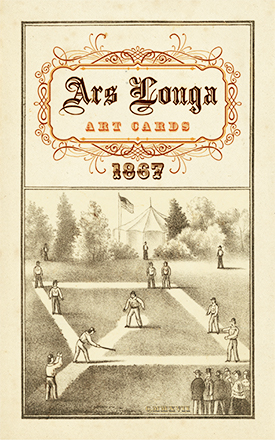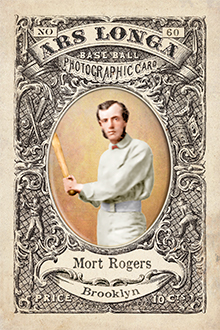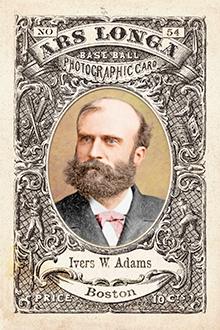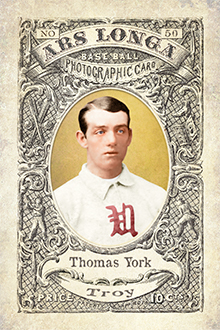- Series: The Old Man
- City: New York
- Team: Union of Morrisania
- League: National Association (NABBP)
As Ars Longa strives to honor the long tradition of baseball-on-cardboard, and as we have great reverence for the history of this storied art form, it is only appropriate that we depict what may be the first-ever baseball card. As with many “firsts,” this entry is not without controversy and partisans. No less an authority than John Thorn has nominated “the illustrated ticket to the inaugural soiree of the Magnolia Ball Club, an event that took place in 1844 to celebrate the club's founding the year before.” The Birdsall card can't compete with the Magnolias in seniority. Yet, it is a card, not an admission stub.
In 2013, REA offered the famed “1863 Harry Wright 'Grand Match at Hoboken'” card as the first. It is a card. It is a photographic image of a ballplayer, indeed perhaps the most famous of the early game. But it doesn't identify him. And, like the Thorn favorite, it is clearly an admission ticket to a three-game cricket/baseball exhibition. Another contender is the “only known pre-Civil War baseball team card” as the circa 1860 Brooklyn Atlantics' carte-de-visite was billed when Heritage Auctions offered it in 2015. Is a calling card a baseball card? It wasn't sold as advertising, it wasn't even sold. Such vehicles were used by teams to gift their inner circles of family and friends, more mementoes than collectibles, perhaps?
Ars Longa's Pioneer Portraits I series celebrates another candidate for “first” status: Mort Rogers. His scorecards contained photos of players that were cut into what was probably the first “set” of baseball cards. But he was a printer promoting team events and wasn't involved in the earliest entries in the competition at hand.
Enter our “Old Man.”
Dave Birdsall was the “grizzled” and dour catcher for one of the great teams of the early post-war era. In 1867 he and battery-mate Charlie Pabor led the Unions of Morrisania (lower Bronx) to the first championship outside of Brooklyn. Birdsall's gloomy demeanor was undoubtedly spawned by the rigors of catching in the days when backstops wore no protection; and he was, by far, the eldest member of the squad. Pabor was famously dubbed The Old Woman in the Red Cap. So, perhaps, Birdsall, as the oldest guy on the team and battery mate of The Old Woman, naturally became The Old Man. Years later, when Harry Wright selected Birdsall to staff the Boston Red Stockings in 1871, Dave was again many years older than the next-oldest player.
The card is a hand-drawn image of a Union of Morrisania player labeled “The Old Man.” When Robert Edward Auctions (REA) offered the card in 2008, they mis-identified it as depicting Bernie Hannegan, who had gained a measure of infamy as the star hurler for the Unions when Jim Creighton swung, missed and died of injury, becoming the first “martyr” of baseball in 1862. REA issued a lengthy mea culpa thanking the Wentz brothers for straightening out the mix-up and crediting Birdsall as the player on "The Old Man” card. In support of the “first-card” standing, REA offers: “It is the only card from this early era that we have ever seen featuring the image of a specific current player who is identified on the card.” These, they assert, are “defining characteristics for baseball cards, dating from the 1880s all the way up to modern cards.”
1867-1868 Union of Morrisania Champion Base Ball Club. Dave Birdsall is pictured fifth from left; Charlie Pabor is sixth from left.
It is appropriate to the legend of these friends and their nicknames that The Old Man and The Old Woman in the Red Cap are standing side-by-side in the center of this team image.
